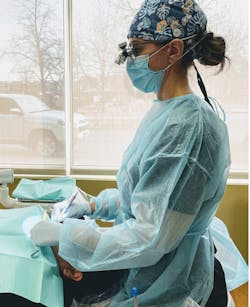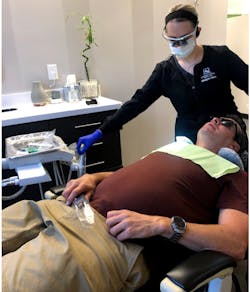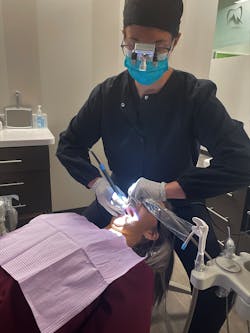Oops, I did it again! Top 5 ergonomic mistakes in hygiene
It's no secret that being a dental hygienist is rewarding, exciting, fulfilling, and these days, in high demand. However, there are other less happy things that are also no secret to hygienists—the aches, pains, fatigue, burnout, and risk of injury and disability that are far too common due to the intense physical nature of our work. A recent study reported that 91% of dental hygienists say they have or had a musculoskeletal disorder (MSD).1 While there are some things out of our control when it comes to practicing dental hygiene, there are many things we can improve to better care for ourselves and keep our bodies and minds healthy.
As an ergonomics coach for dental professionals, I've observed many hygienists as they work on patients. While each person is unique, there are some common areas of improvement I talk about with clinicians. Improving these areas makes a significant difference in the health of their musculoskeletal system and how they feel. I’ll share the top five oversights and how to improve them.
Mistake 1: Not prioritizing yourself in the operatory
For the most part, dental hygienists are caretakers. This quality makes us great at our jobs and is why we have such strong relationships with our patients. But we mustn't let this character trait prevent us from caring for ourselves. I encourage my clients to start with themselves when going into an appointment. Think about how you will adjust your patient correctly to maintain a neutral posture. Determine when you will put down your instruments during the visit to take a 20-second microbreak. Keep chit-chat to a minimum so you have extra time at the end of the appointment to take a restroom break, eat a snack, drink some water, or stretch.
More by Stephanie Botts
Common ergonomic errors and solutions for dental hygienists
Nearly 100% of hygienists have pain on the job. What can you do?
Mistake 2: Not establishing a neutral posture
I frequently address neutral posture with my clients and in my lectures. Neutral posture is the body position that allows for the most support with the least amount of muscle activity. Most of us become injured or feel pain because we’re not practicing in a neutral posture. Is this possible all the time? No, but it is attainable more than we may believe. An easy way to visualize neutral posture is a straight line in the profile view from your ear, shoulder, hip, and foot (if standing). When sitting, the concept is the same. In addition, both feet should be firmly planted on the floor with arms close to the sides, and the elbows bent at 90 degrees as in figure 1. If you focus on establishing a neutral posture first, you can adjust the equipment (and patient) to support you in neutral. Typically, hygienists run into the operatory and get right to work without even thinking of establishing a healthy posture first.
Mistake 3: Failing to correctly position the patient
This is one of the most common mistakes I see when I assess hygienists, dentists, and assistants. Taking the time to position patients properly is vital, as their position dictates ours. A good rule of thumb is when you are in neutral posture, the patient's mouth should be at your elbow level. Typically this requires reclining the patient all the way back, which many clinicians are not comfortable doing. However, having the patient too high leads to shoulder abduction, prolonged contraction of the upper trapezius, forward head posture, and more. So when I coach my clients, we work on ways to help them be more confident about positioning their patients and how to manage patient protests when reclining them back.
Mistake 4: Reaching
Another prevalent error is reaching. (In this case I'm referring to full extension of the arm.) We reach for instruments, suction, the overhead light, supplies, the computer, and more. In ergonomics, we talk about movement classifications. Movements start with just the fingers (Class I) and go up to the full extension of the arm with torso rotation (Class V). Class IV is the arm's full extension, which I often see in the dental operatory (figure 2). Prolonged or repeated reaching can cause injury to the back, shoulder, and neck, to name a few areas. I advise hygienists to evaluate their operatory and the placement of their equipment. I encourage them to place their most frequently used items within easy reach. It's a great practice to keep your instrument tray, suction, and ultrasonic very close to you to reduce the harmful reaching habit.
Mistake 5: Failing to use a suction device
Many hygienists use the saliva ejector or the HVE while using the ultrasonic for suction and retraction. Working this way is a problem for a couple of reasons. We typically use excessive force when holding onto the suction, which causes pressure to build up in the carpal tunnel and fatigues the muscles in our forearms, shoulder, and neck (figure 3). Depending on your equipment, the cord can be quite heavy and can contribute to the amount of force needed to hold onto it and retract and stabilize it as well.
Another issue is not being able to use indirect vision. If you are not using a mirror to visualize, you cannot keep neutral posture and sometimes are literally almost upside down trying to see, especially the linguals of the maxillary arch. I recommend different suction devices depending on the operator, the layout, and any concerns about aerosol mitigation.
We hygienists have so much to think about during our appointments. To reduce our pain and fatigue, we have to start making these adjustments in the operatory. Many hygienists regularly stretch, exercise, and see multiple health professionals, such as physical therapists, chiropractors, massage therapists, and others. If we aren't addressing exactly what we’re doing in the operatory and how we’re using our bodies, we’re simply spinning our wheels. Ergonomics is all about the little things, and it's those little things that will make or break us.
Editor's note: This article appeared in the October 2022 print edition of RDH magazine. Dental hygienists in North America are eligible for a complimentary print subscription. Sign up here.
Reference
1. Saccucci M, Zumbo G, Mercuri P, et al. Musculoskeletal disorders related to dental hygienist profession. Int J Dent Hygiene. May 2, 2022. doi.org/10.1111/idh.12596
About the Author
Stephanie Botts, BSDH, RDH, CEAS
Stephanie Botts, BSDH, RDH, CEAS, has been a clinical dental hygienist for over 17 years. She is a certified ergonomics assessment specialist providing both in-office and virtual ergonomics consulting and coaching to dental professionals. She also provides CE to dental and dental hygiene associations on ergonomics. Stephanie believes that by learning effective strategies to optimize proper ergonomics, dental professionals can practice pain-free and ensure career longevity. She can be reached at [email protected] or on Instagram at @steph.polishedposture.




